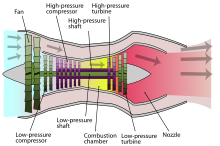Bypass ratio

The bypass ratio (Engl. Bypass ratio , BPR ), also bypass ratio called, is an expression of aeronautical engineering. In a twin- flow jet engine, it describes the relationship between the air mass flow that is routed past the fan outside the gas turbine (bypass flow or bypass flow ) and the air mass flow that passes through the combustion chamber of the engine and provides the shaft power ( core flow ).
Modern civil jet engines have bypass ratios of 5: 1 to 11: 1. The next generation of civil engines, such as the Pratt & Whitney PW1000G , will even increase the bypass ratio up to 12: 1.
Military turbofan engines for the supersonic range up to about Mach 2.5 typically have a bypass ratio of about 0.3: 1 (for example Snecma M88 ) to over 1: 1 (for example RB199 ), as this is an optimum between the resistance through the face and the economy through the bypass flow.
Turboprop engines achieve a fictitious bypass ratio (propeller flow compared to the mass flow through the engine) of around 100: 1.
Individual evidence
- ^ Willy JG Bräunling: aircraft engines . Basics, aero-thermodynamics, ideal and real cycle processes, thermal turbo machines, components, emissions and systems. 4th edition. Springer, Berlin 2015, ISBN 978-3-642-34539-5 , pp. 39 .
- ^ Willy JG Bräunling: aircraft engines . Basics, aero-thermodynamics, ideal and real cycle processes, thermal turbo machines, components, emissions and systems. 4th edition. Springer, Berlin 2015, ISBN 978-3-642-34539-5 , pp. 40-56 .
- ^ M88: performance and exceptionally carefree handling. In: safran-aircraft-engines.com. Retrieved April 24, 2019 .
- ^ Willy JG Bräunling: aircraft engines . Basics, aero-thermodynamics, ideal and real cycle processes, thermal turbo machines, components, emissions and systems. 4th edition. Springer, Berlin 2015, ISBN 978-3-642-34539-5 , pp. 58 .